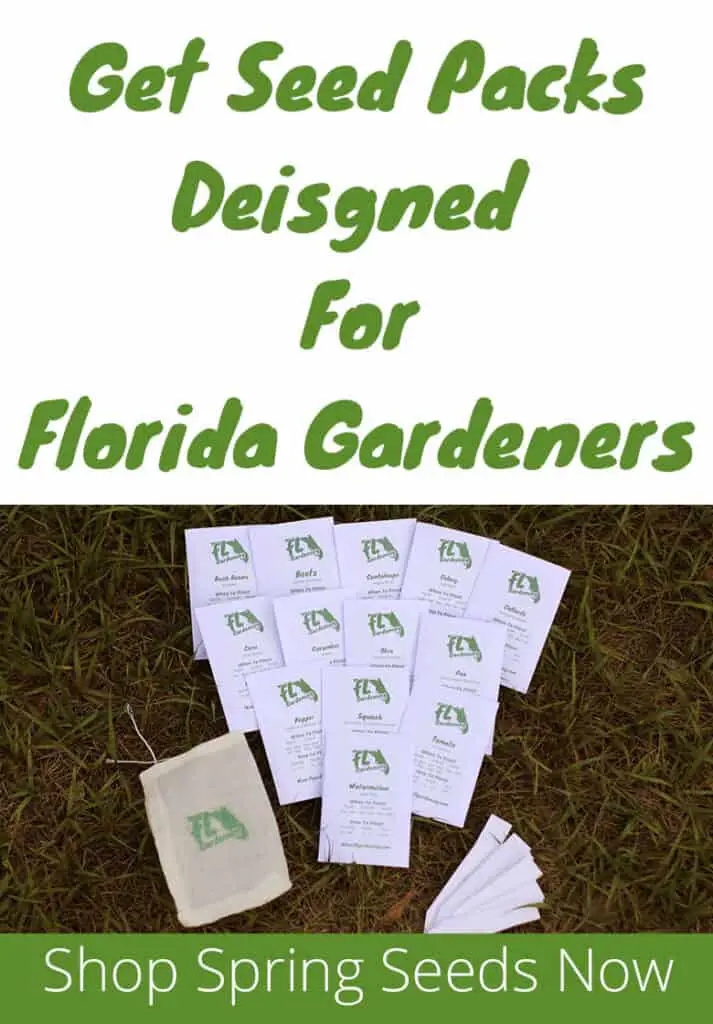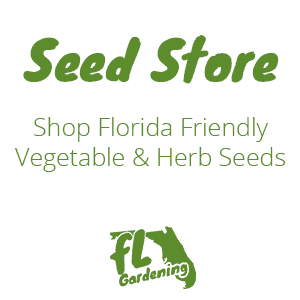Florida vegetable gardening provides unique growing conditions with hot summers, occasional freezes, and high humidity. The state’s long length, over 900 miles, offers varied climates from frost-free southern areas to northern regions experiencing regular freezes. Understanding your zone—North, Central, or South Florida—is crucial as each has different planting schedules and seasonal patterns. Timing is key in gardening; in Florida, it differs from other states due to its intense summer heat and the possibility of frosts in the central and north zones. Successful gardening also involves knowledge of suitable plant varieties that can withstand local weather and resist common pests and diseases
Florida vegetable gardening, just like anywhere-else-gardening, can be a little tricky at first.
Have you ever tried your hand at gardening in Florida, only to find that your tomatoes have been wrecked by bugs and withered away by diseases?
Or, maybe you let the fear of murdering innocent plants take hold of you and stop your thoughts of gardening right in their tracks.
You’re not alone.
Gardening in Florida offers unique growing conditions.
Hot-ass summers, some parts freeze and humidity is usually on max. All the time.
Us, Florida gardeners don’t follow a lot of the same rules that other gardeners follow.
In particular: timing.
Our green babies are grown at different times of the year and face different environmental pressures than most states
We actually have great growing conditions as long as you know when, where and what to plant.
Life in the garden will be so much more enjoyable when you learn which varieties grow best for you and when to plant them.
Another key to success is learning about what bugs are going to try and eat your plants; because they are gonna try. And if you’re not ready they are gonna enjoy your plants more than you will get to.
The warm, wet, humid nights are like a bacteria’s ideal date night. They are gonna breed and spread!
Always remember
An ounce of prevention is worth a pound of cure.
Some gardener somewhere
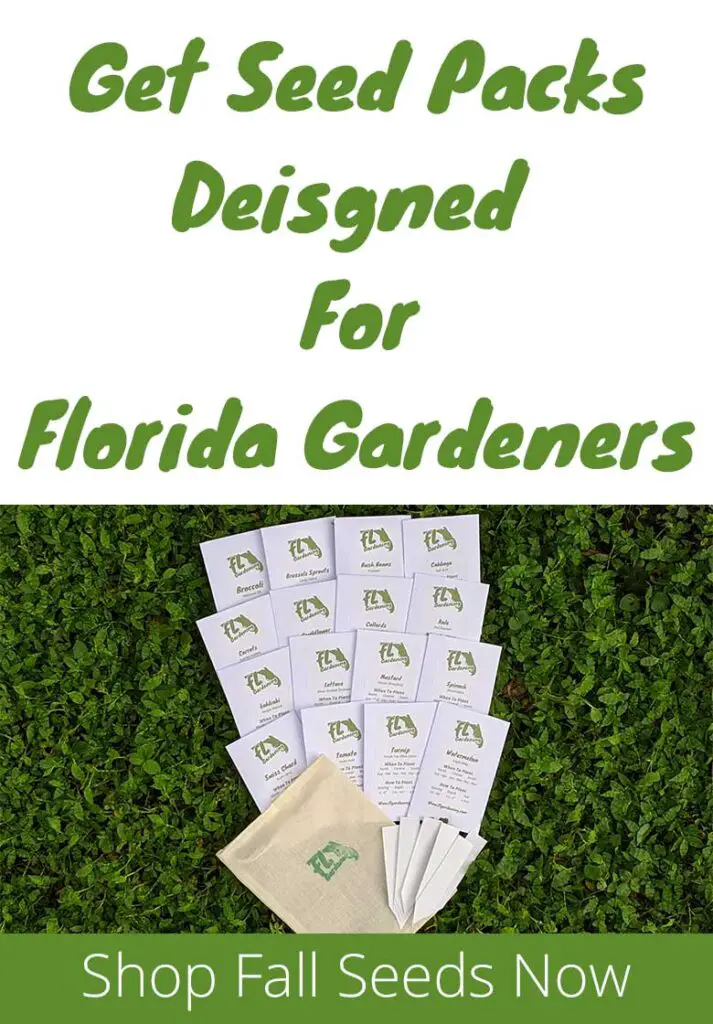
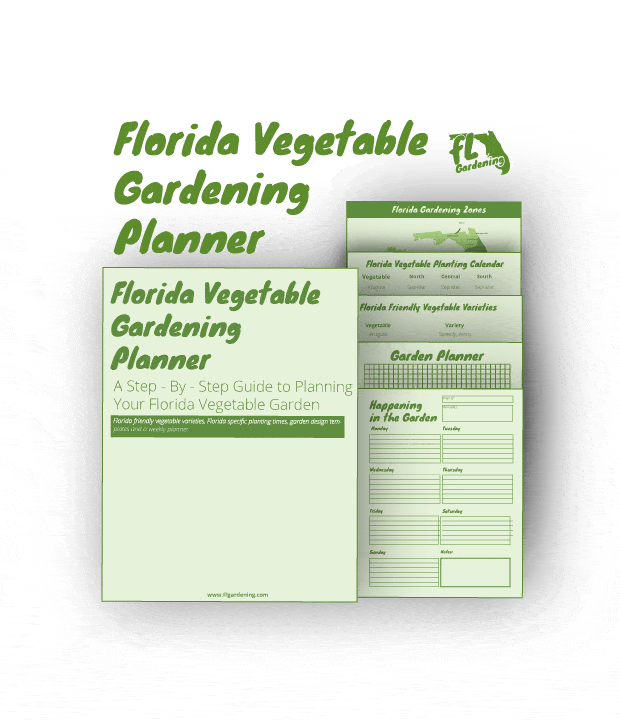
Get your Free Florida Vegetable Gardening Guide.
Florida’s climate
Florida is a long state, ranging 900 miles from top to bottom.
You can grow without the thought of frost in the southern growing areas, while the northern parts of Florida have regular freezes each year.
Florida has a range of weather but it is somewhat predictable.
Ask any Floridian and they will tell you this:
Spring and fall are hot but bearable.
Our winters are quite short
And summer is hot and wet as Hell
My First Experience In Florida Vegetable Gardening
My first garden was a 4’x4’ raised bed.
I took the popular advice to start small.
My garden was physically small but my list of things I wanted to plant was large.
I planted a watermelon, two beefsteak tomatoes, 18 onions, an eggplant and 6 bush beans.
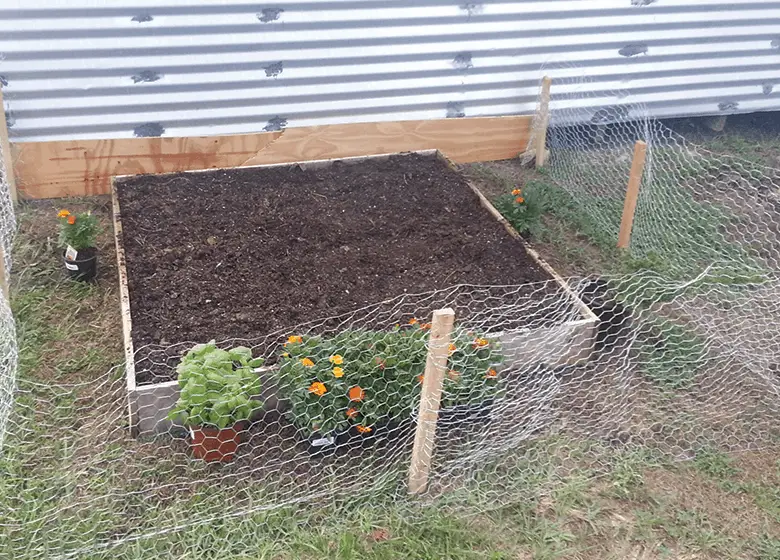
Needless to say, that garden didn’t end well.
Although I didn’t grow and pick any fruit, I did harvest plenty of education.
I had a ton of fun watching the plants grow and learned a lot as I watched them die.
Each plant needs a certain amount of space, and when you overcrowd plants they start to fight each other for valuable resources: like water, sun and soil.
Pests also see these weak, over-crowded plants as a buffet.
I grew too many large vegetables in my little raised bed at first.
What would have worked in that space?
I think one well-groomed tomato, a bean plant or two, and lots of lettuce would have been a much better plan of attack for that garden.
Fast forward 3 years.
Now I garden with two 3’x8’ raised bed gardens, and I find that’s to be enjoyable amount of work-to-harvest ratio.
Size is relative though; maybe you are feeling frisky and have the room for four 3’x12’ gardens.
Do it! Just make sure the area gets at least 6 hours of sun and that you won’t hate the chore of daily maintenance.
‘Cause there is always something to do in the garden.
Know your zone
North Florida
- Extends from the top of the state all the way to Ocala
- Actually has seasons
- Planting schedule is most similar to that of other states
- Experiences regular frosts and some freezes between November and late February
- Hot, humid summers
Central Florida
- Includes places like Daytona beach, Orlando, Tampa and Lake wales
- Experiences frosts and light freezes in January and February
- Brief moments of fall in November and December
- Spring exists in March and April
- Mostly warm and humid throughout the year.
South Florida
- Includes
Sarasota , West Palm Beach, Miamiand The Keys - Topical to sub-tropical region
- The northern parts may see an occasional frost but no threat of freeze
- Fall and Spring are more like summer conditions when compared to everywhere else.
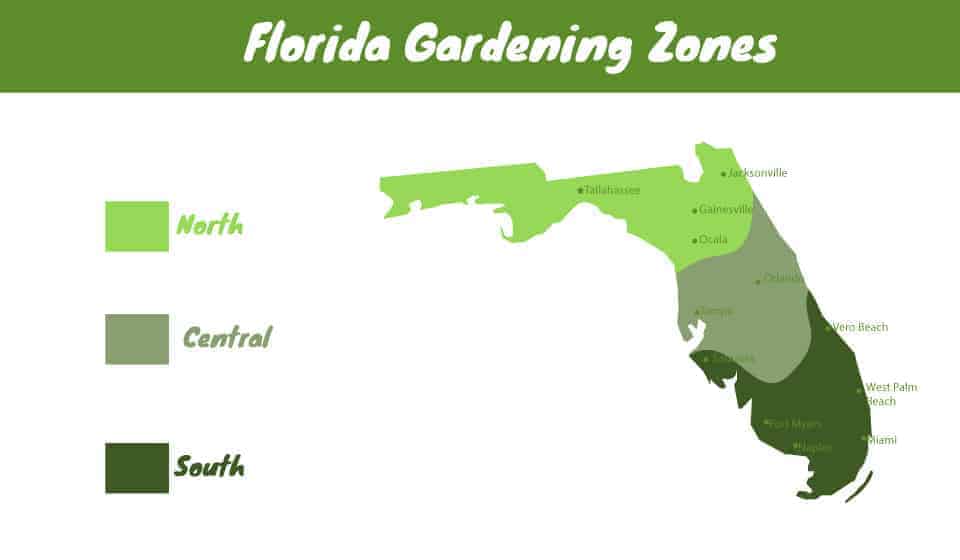
North Florida goes down to Ocala. South Florida starts at Sarasota and extends down. The central zone is all the space in the middle, like Tampa and Orlando.
Each zone is characterized by the date of the average last frost. This is important to understand because this helps us dial in our timing.
Florida Vegetable Garden Planting Schedule
As with most things in life, Gardening also requires careful timing.
Getting the time right will spare you tons of headaches and heartaches.
This is the part that throws most gardeners off, especially if you are from up North.
The right time to plant things up there is not the same as it is down here. Our intense summer heat can pound your plant into the ground, and if you’re in the central and in north zones of the state a frost or freeze can roll through and “burn” your plants up.
We base our Florida planting schedule on the average date of
| Vegetable | North | Central | South |
| Arugula | Sep – Mar | Sep – Mar | Oct- Mar |
| Beans | Mar -Nov | Oct – Apr | Oct – Apr |
| Beets | Sep – Mar | Oct- Mar | Oct- Mar |
| Broccoli | Sep -Jan | Sep -Jan | Sep -Jan |
| Brussel Sprouts | Sep -Jan | Sep -Jan | Sep -Jan |
| Cabbage | Sep -Jan | Sep -Jan | Sep -Jan |
| Cantaloupe | Mar -Apr | Feb – Apr | Aug & Feb |
| Carrot | Sep -Mar | Oct – Mar | Oct – Feb |
| Cauliflower | Sep -Jan | Sep -Jan | Sep -Jan |
| Celery | Jul – Sep | Jul – Sep | Jul – Sep |
| Collards | Jan – Dec | Jan – Dec | Jan – Dec |
| Corn | Feb – Apr | Jan – Apr | Oct – Mar |
| Cucumber | Aug – Sep & Feb -Apr | Sep & Jan – Mar | Sep -Mar |
| Eggplant | Jun – Sep | Jun – Sep | Jun – Sep |
| Kale | Sep – Mar | Sep – Mar | Sep – Mar |
| Kohlrabi | Sep – Mar | Sep – Mar | Sep – Mar |
| Lettuce | Sep & Feb | Sep – Mar | Sep – Jan |
| Mustard | Sep – May | Sep – Mar | Sep – Mar |
| Okra | Mar – Aug | Mar – Aug | Aug – Sep |
| Onion | Sep – Mar | Sep – Mar | Sep – Mar |
| English Pea | Jan – Mar | Sep – Feb | Sep – Feb |
| Southern Pea | Mar – Aug | Mar – Aug | Aug – Apr |
| Pepper | Feb & Jul | Feb & Jul | Aug – Sep |
| Potato | Jan – Mar | Jan – Mar | Sep – Jan |
| Spinach | Oct – Nov | Oct – Nov | Oct – Jan |
| Squash | Mar & Aug | Feb & Aug | Jan – Feb & Sep |
| Sweet Potato | Mar – Jun | Feb – Jun | Dec – Sep |
| Swiss Chard | Sep – Mar | Oct – Mar | Oct – Mar |
| Tomato | Feb & Aug | Mar & Aug | Aug – Mar |
| Turnip | Jan – Apr & Aug – Oct | Jan – Mar & Sep – Nov | Oct – Feb |
| Watermelon | Mar & Jul | Jan – Mar & Aug | Jan – Mar & Aug – Sep |

Get your Free Florida Vegetable Gardening Guide.
Florida Vegetable Varieties
You can’t grow a bunch of Yankee plants down here. – David the good
Vegetables are wild!
There are so many different varieties of every plant, it’s head spinning.
Let’s talk eggplant, for example.
There are white eggplant, tall and skinny eggplants, short and fat eggplants and ones with tiger stripes!
Nature, you crazy.
However, not all of these varieties will grow well here.
Knowing which plants can stand our weather, and have the ability to fight off some common diseases and pests will give you an extra step up.
| Vegetable | Variety |
| Arugula | Speedy, Astro |
| Beans, Bush | Bush Blue Lake, Cherokee Wax, Contender, roma II |
| Beans, Pole | McCaslan, kentucky Wonder, Blue Lake |
| Beans, Lima | Dixie Butterpea, Early Thorogreen, Fordhook 242 |
| Bans, Shell | Black Bean, Garbanzo, Navy, Pinto, Red Kidney |
| Beets | Cylindra, Detroit Dark Red, Early Wonder, Tall Top |
| Broccoli | Early Green, Packman, Waltham |
| Brussel Sprouts | Jade Cross, Long Island Improved |
| Cabbage | Copenhagen Market, Savoy, Red Acre, Wakefield |
| Cantaloupe | Ambrosia, Bush star, Honey Rock |
| Carrot | Chantenay, Danvers, Impertor, Nantes |
| Cauliflower | Brocoverde, Snowball |
| Celery | Utah |
| Collard | Georgia Southern, Morris Heading, Vates |
| Corn | Early Sunglow, Sweet Riser, How Sweet It Is, Silver Queen |
| Cucumber, Slicers | Ashley, Marketmore 76, Poinsett, Sweet Success |
| Cucumber, Picklers | Boston, Eureka |
| Eggplant | Black Beauty, Cloud Nine, Dusky Long, Ichiban, Florida Market |
| Kale | Lacinato, Red Russin, Winterbor |
| Kohlrabi | Early White Vienna, Purple Vienna |
| Lettuce, Butterhead | Ermosa, Bibb, Tom Thumb, Buttercrunch |
| Lettuce, Looseleaf | Black Seeded Simpson, Red Sails, Oak Leaf, Salad Bowl |
| Lettuce, Romaine | Parrid Island Cos, Outredgeous |
| Mustard | Florida Broad Leaf, Giant Red, Southern Giant Curled |
| Okra | Aninie Oakley II, Cajun Delight, Clemson Spineless, Emerald |
| Onion | Chippolini White, Matador Shallot, Granex, White Libson |
| Pea, English | Green Arrow, Oregon Sugarpod II, Sugar Snap, Wando |
| Pea, Southern | California Blackeye No 5, Hull, Pinkeye Purple, Texas Cream |
| Peppers Sweet | Big Bertha, California Wonder, Sweet Banana |
| Pepper, Hot | Ancho, Cayenne, Ghost Peper, Habanero, Jalapeno, Reaper |
| Potato | French Fingerlings, Red Pontiac, Yukon Gold |
| Spinach | Bloomsdale, Longstanding |
| Squash, Summer | Crookneck, Early White Scallop |
| Squash, Winter | Spaghetti, Early Butternut, Waltham |
| Squash, Zucchini | Black Beauty, Cocozelle, Spineless Beauty |
| Sweet potato | Beauregard |
| Swiss Chard | Bright Lights, Fordhook Giant, Red Ruby |
| Tomato, Determinate | Celebrity, Tasti-Lee, Floragold |
| Tomato, Indeterminate | Better Boy, Bonnies Best, Everglades, Sweet 100 |
| Turnip | Purple Top White Globe, Seven Top |
| Watermelon | Charleston Grey 133, Crimson Sweet, Jubilee, Sugar Baby |
We will talk more about spacing and how to plan your garden later in this article.
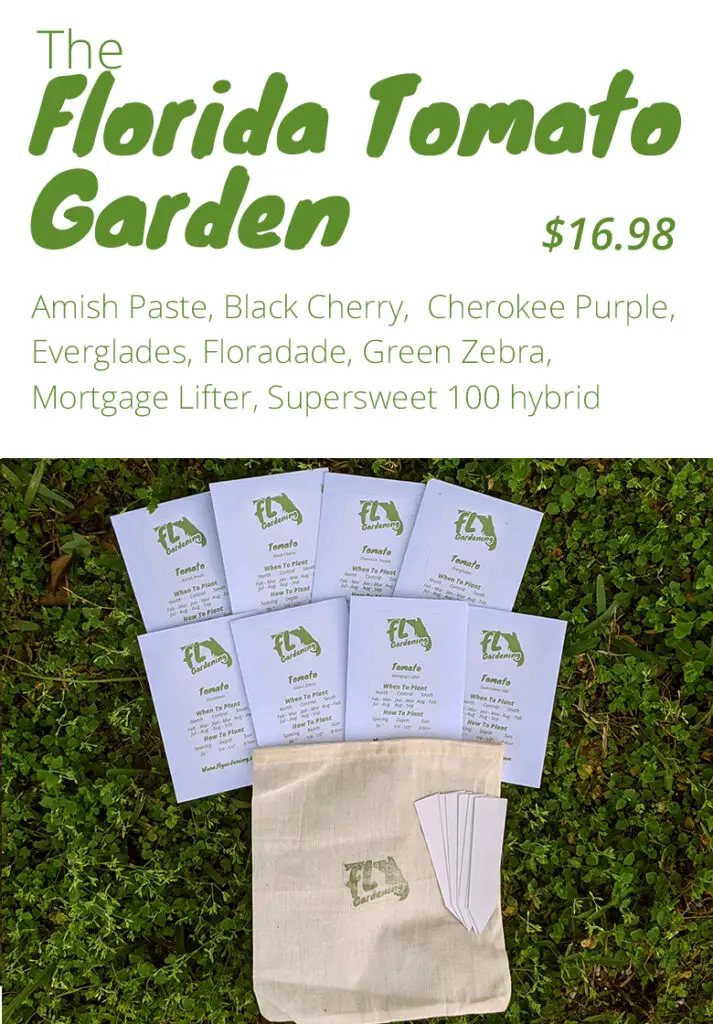
Keep A Journal
Keeping track is one of the most important things that you can do.
It doesn’t have to be anything fancy. It can just be a note-taking app on your phone or even your Google calendar.
The method doesn’t matter as much as the data collection does.
It’s so important to make a note of when you plant, fertilize and begin to notice pests.
This will help you stay on a regular schedule.
I’ve also found it super helpful to note how the weather has been.
If something goes wrong with my plant I can look back and remember that it rained for 5 days straight.
A journal is also a great place to doodle up a pretty simple layout of your garden.
Planning And Designing
Spending time planning your garden is time well spent.
The better your plan the more successful your garden.
Don’t underestimate having a plan.
Ok I’ve said that enough, but to get the point across I’ll say it once more for good measure.
It pays to have a plan!
A good plan answers these simple questions:
- Where will my garden go?
- How much space do I have?
- What veggies do I enjoy eating?
When you are thinking about where your garden will go you need to think about the location of the sun and where it’s light will fall throughout the year.
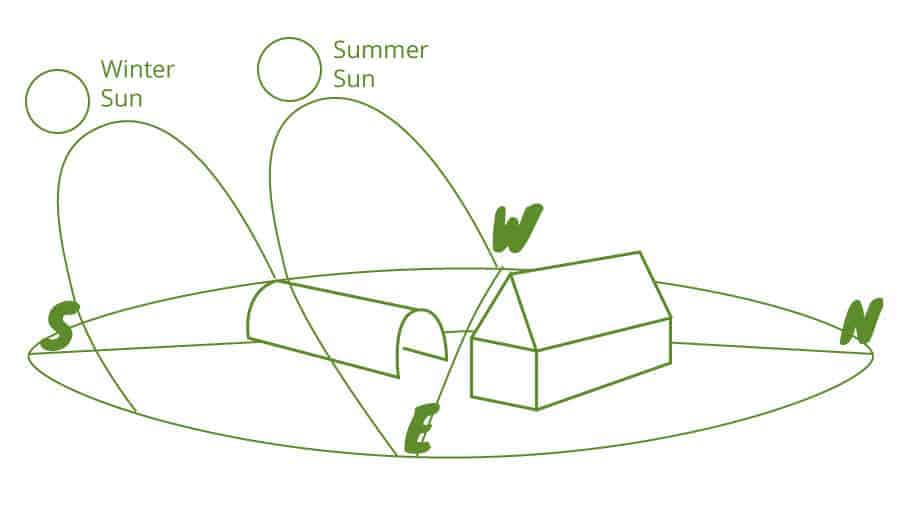
Ensuring that your plants get at the very least 6 hours of sun is critical to a healthy thriving garden.
6 is the bare minimum you need.
8-9 is ideal.
And if possible, try and let the plants soak up lots of morning sun.They love the early rays.
Before I started gardening I never really paid attention to how much the sun’s light actually changes throughout the year.
Makes me feel weird to think that we are just on a giant,
How Much Space Are You Working With?
Specifically how much space with good light.
This will dictate the size of your garden and what you can grow.
If you’ve only got a small back porch that gets 6 hours of sun, then that’s alright.
You can still use your green thumb to grow some veggies.
Here are some dwarf varieties of many popular vegetables that will grow well here in Florida.
Florida Friendly Dwarf Vegetable Varieties
| Vegetable | Variety |
| Bean | allicante, Golden Child |
| Beet | Baby Ball |
| Cabbage | Baby Pixie |
| Carrot | Atlas, Little Finger, Parisian, Round Romeo |
| Cauliflower | Snowball |
| Cucumber | Bush Champion, Very Kuhl, Spacemaster |
| Eggplant | Bambino, Pot Black |
| Kale | Dwarf Blue Curled |
| Lettuce | Bambi, Claremont, Little Gem, Tom Thumb |
| Pea, English | Half Pint, Little Marvel |
| Pumpkin | Baby Boo, Jack Be Little, Small Sugar |
| Tomato | Patio, Small Fry, Tiny Tim |
All of these varieties are an excellent choice if you are gardening in containers or pots.
I’ve seen some pretty amazing porch gardens.
If you want to get real cheap you could just get some 5-gallon buckets, drill some holes in the bottom and throw some good soil in there and be all set to go.
But if you do have the space to grow a little more then I would suggest throwing up a raised bed.
You can be really creative with these.
Raised beds don’t have to be square, like the ones I have. You can make them in U shapes, You can do circles, you can even just mound some dirt up and make whatever pattern you want.
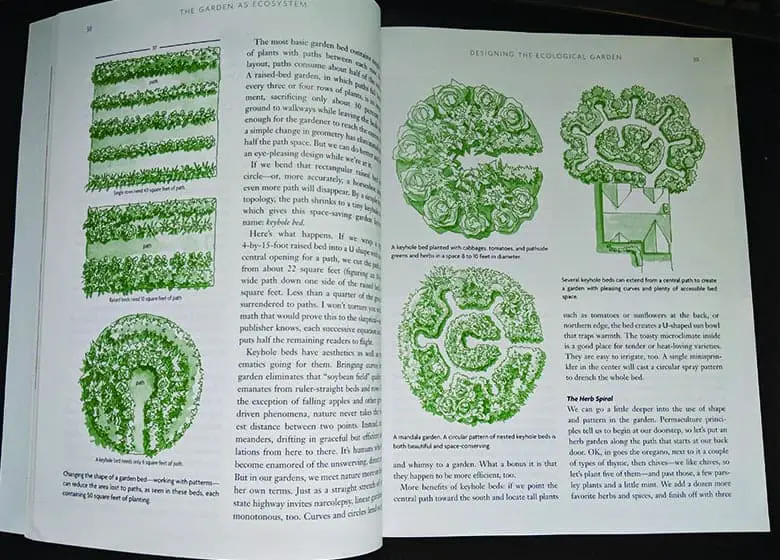
Tip: Avoid making your raised bed wider than 4 feet. You don’t want to have to step into the garden to work.
Sketch It Out
Now that you’ve assessed your situation and know what you’re working with.
A small porch or a backyard, it doesn’t matter, sketch out a quick and dirty outline of the garden you plan to plant.
Once you know exactly how much space you are working with it’s helpful to know how much space each plant will take up.
The above-mentioned dwarf varieties of these plants do not apply to these generalized spacing guidelines.
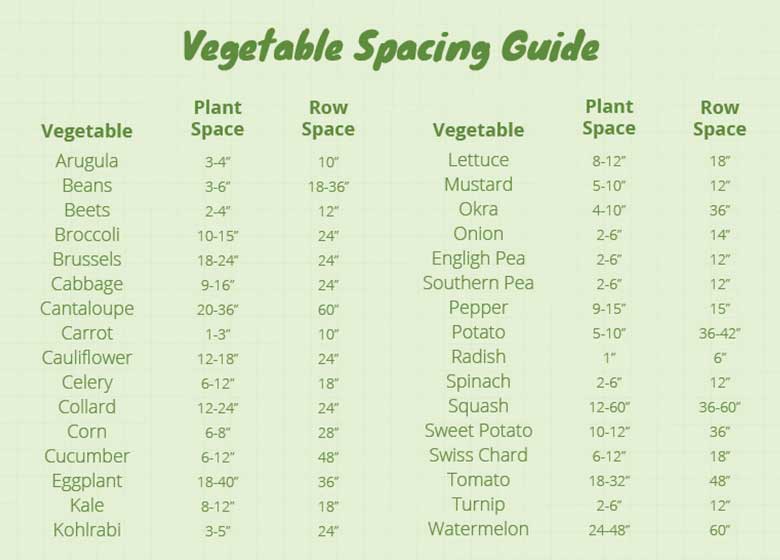
Keep in mind that every variety will grow a little bit different. For example, a beefsteak tomato will grow much differently than an Everglades tomato. The beefsteak will be a bit stalkier and not spread as much as an Everglades tomato that grows wild and vine-like.
Also in this time of the planning, it’s super helpful to think of the garden in terms of layers.
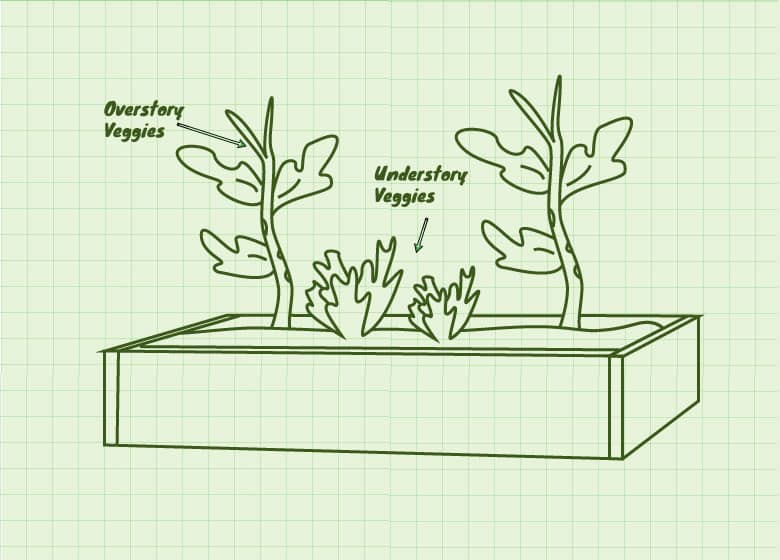
This principle is actually mimicing how the forest naturally grows.
There are overstory plants and understory plants.
This way you can plant certain “understory” veggies that love the sun but can’t take the intense midday heat.
These are usually soft-leafed greens like black-seeded Simpson lettuce for example.
If you’ve got a 4×4 garden and want to grow tomatoes, beans, basil and lettuce you could lay something out like this.
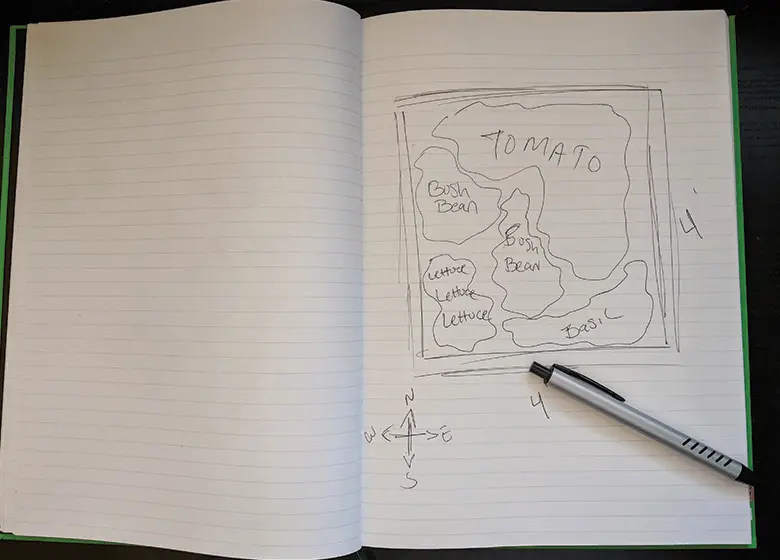
You Might Also Be Interested In: Florida Vegetable Garden Layouts
Soil
Vegetables prefer a soil that is the perfect mixture of sand, silt and clay.
There are very few parts in Florida that won’t require some kind of soil amendment if you’re looking to plant directly into your little piece of dirt.
Florida soil is made up of sand for most of the southern and central parts of the state while parts of the panhandle are mostly made of clay.
Our Florida soil isn’t always the best when it comes to growing most vegetables and a raised bed or planting in pots will eliminate some of the issues.
Soil health is one of the most important factors when it comes to gardening. Soil is something that is alive, We must start thinking of soil differently. It’s not just dirt , Making sure your soil is alive with healthy microorganisms and insects is critical.
I can’t stress how important healthy soil is to the ecosystem of the garden.
A good soil will have plenty of air pockets, stay moist but not soaked and be full of organic materials.
The soil mix that I really like using is:
- 40% Peat moss
- 40% Compost
- 20% perlite
- Worm castings
- Mykos
It’s always best to support your local shops. So if you have a good nursery or gardening shop, check them out before your order on Amazon.
Soil texture refers to the particles that are in the soil. Sand particles are large and coarse, the problem with a soil that is mostly is that it doesn’t hold water or nutrients very well.
Soil that has lots of clay or silt will not allow water to pass through easily. Those Particles are very fine and compacted.
Soil Structure is different from texture. The structure is more about how the soil holds together. Ideally, soil falls apart into pea-sized pieces when you crumble it up. Good structure comes from how much water, air, and organic material are mixed with your soil.
Ph of soil is another important factor. If the PH is out of whack your plants won’t be able to take up all of those great nutrients that you have added to your soil.
Generally speaking most veggies like a ph of between 5.5-6.5.
You can get a cheap test kit to get an idea of what you’re working with, or you can locate your local extension office and have them test it for you for about 3 bucks. The extension office test is much more accurate.
Compost
You don’t even have to buy compost if you don’t want. You can actually make your own.
If you want some hands-on practice you can go to a free course. In
The quick and dirty way though is by mixing “browns” and “greens” together, watering and stirring them up every few days for a few months.
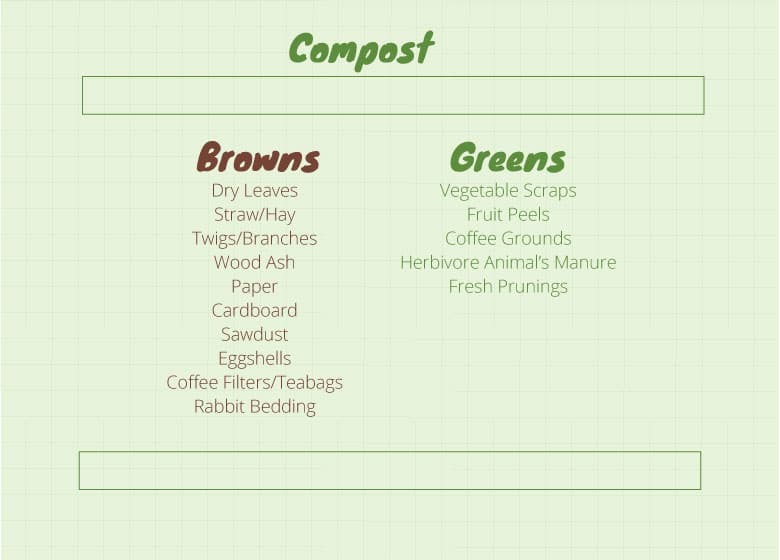
Some real life examples of brown compost materials would be:
- hedge trimmings
- Newspaper
- Junk mail(Avoid the glossy ones)
- Toilet paper and paper towel rolls
- Pizza boxes
- Your neighbor’s bagged leaves
The ideal ratio of browns to greens is for every 25-30 parts brown you should have 1 part of
This creates the perfect environment for microorganisms to decompose all of those ingredients.
The ratios are hard to nail down exactly, I always just keep in mind that I’m supposed to have a lot more browns than I should greens. You will know that you have too many greens in your pile if it starts to stink. A good pile of compost will smell like fresh dirt.
If you have too many browns in your pile, decomposition will slow way down. As you water and turn the pile, you should notice a slow but definite change. IF your pile looks the same week after week, try adding more greens to the mix.
Mulch
We can’t talk about soil and not mention mulch.
Mulching your garden is a HUGE deal.
Mulch helps retain moisture in the soil and adds organic material that will eventually turn into nutrients for you garden.
It’s also a weed barrier. Don’t get me wrong, weeds will still grow, just a lot less of them will grow when mulched.
You also don’t even have to buy mulch. You can use dead leaves from your yard.
Or neighbor’s yards.
There are always bags of leaves if you look around.
Starting From Seed
Will you be starting from seed? It’s not that hard. Build great soil, plant your seeds and make sure the ground stays moist.
Starting from seed is a lot of fun.
You get an inflated sense of pride when you see mature plants that you once knew as a tiny seed.
I helped raise that and now it’s making me food.
It’s also a little bit of extra work.
The major benefit though of starting from seed is that you can choose any variety of veggie that you want.
Lots of times, local nurseries won’t have a huge variety.
I mostly mean places like home depot and lowes.
I have a great local nursery near me called Kerby’s and they have a great selection of all sorts of plants.
But they still don’t compare to the kind of options that you can find online.
Also buying seeds is way cheaper than buying baby plants at these nurseries.
Direct sow or transplant?
Direct sow is garden talk for planting directly into the ground.
It’s putting the plant in it’s forever home from the get go.
Transplants are prepubescent plants.
They are started in smaller pots and then moved into the garden.
All plants can be direct sown but not all plants can be transplanted.
Some plants don’t do well when moving from one home to another.
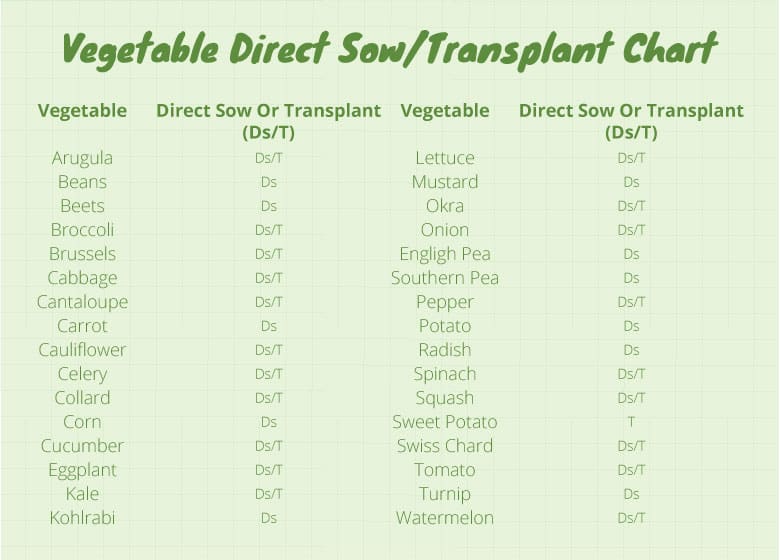
With plants that do well when transplanted you get great benefit of starting them early.
You can start your seeds indoors under a grow light weeks before you’re able to plant them outside due to either intense heat or a frost or freeze
For example if you’re in central florida you can start your tomatoes indoors under a light at the beginning of january so that by the time the fear of last frost passes you have a tomato plant with 3 to 4 “true leaves” on it.
The annoying part of this is that you need to ease your plants into being outside.
This is called hardening off.
You have to help your plants get acclimated to the outside conditions by gradually increasing their exposure to the outside environment.
They are going from having a stable and comfortably bright spot to the burning pits of Florida hell.
From living comfortably in the AC and then having it break.
That would be a stressful time for you and the same goes for your plants.
Easing your plants into the outside conditions can be a pain in the ass if you work a standard 9-5.
The best way to harden off your plants is to start by setting them outside in a shady spot for a few hours a day.
Gradually increasing their exposure to the outside environment by leaving them out there for an extra hour or so everyday and in a slightly less shaded area until they are out there for a full day in full sun and don’t show signs of stress.
The whole process should take about a week.
If you work a standard 9-5 ,It’s inconvenient but not impossible to harden off your transplants.
You will just have to find the perfect spot in your yard.
This requires knowing the sun very well which will take some observation.
You can start the first few days by putting your plants in a shaded area when you get home and then taking them in at night.
Take note of when certain areas get shaded.
You can use the movement of the sun to help you give your plants the perfect amount of direct sun for the day if you can find the right spot.
Watering Your Florida Garden
Just like us humans, plants also need water.
If we go too long without drinking water we die.
Same for plants.
And did you know we can actually drink yourself to death too?
I’m talking about H2O, not alcohol.
Same thing goes for plants. They can have too much water.
You can drown your plants.
And having wet conditions for an extended period of time invites disease, bacteria,fungus and bugs that would love to eat your plants just as much as you want to.
Our rainy seasons can be a problem for many plants.
Also, depending on what type of garden you have will change my recommendations on how to water your garden.
For instance, if you have a container garden of just four or five pots, I’m not going to recommend you get a soaker hose.
That would make your life so much worse.
Water would be dripping all over every thing.
Terrible.
Watering by hand is probably the best option if you’re working with a container garden.
This gives you an excuse to be out there with your plants.
While watering you can really take a good look at them and notice if anything seems a miss.
Are there funny looking leaves or some alien looking bugs creeping around your garden?
However, if you have a small raised bed or larger garden and want to take the easy way out, which actually helps save water at the same time, get a soaker hose.
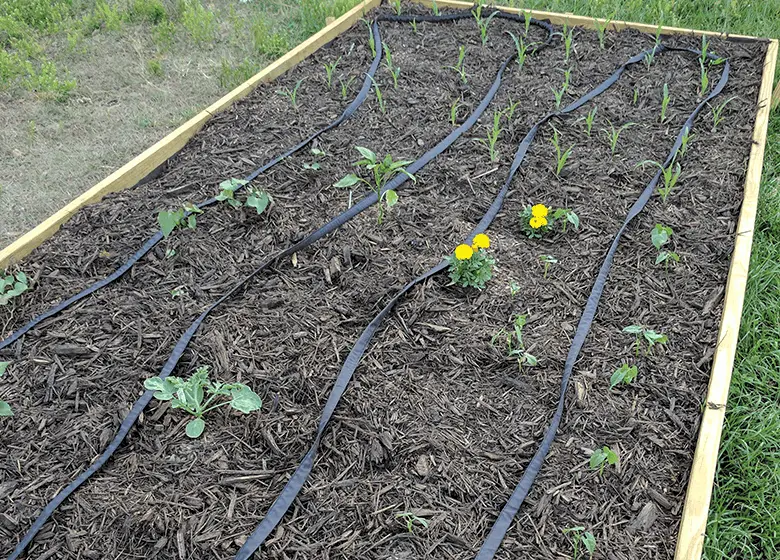
You can just permanently lay it out around the plants roots, turn on the spicket and set a timer.
Or get an automated attachment to your spicket (like this one) so it does all the work for you.
When Should You Water?
When the top inch of the soil seems dry.
This could be twice a day
This could be three times a week.
It’s hard to give a timeline. Every garden will have different conditions.
The easiest way to know is to go out and look around your garden.
Poke your finger in the dirt, look at your plants.
You’ll know when they need water.
They will start to look droopy and a little sad.
Your soil structure will affect your watering habits.
Sandy soils drain faster than clay soil.
The more sun exposure the more it will need to be watered.
Rain will obviously change your watering schedule as well.
This is something that us florida gardeners know too much about.
We can have weeks of afternoon downpours.
Another benefit to a drip irrigation system like a soaker hose is that it keeps water off of the leaves of the plants.
Plants like tomatoes and watermelons are susceptible to diseases when their leaves stay wet.
Note: it’s safe to avoid handling any of your plants while they are wet. This is a good precaution to take that will help to eliminate disease spread between plants.
Keeping the leaves dry while watering by hose or watering can is something that gets harder to do as the garden grows.
Also, the ideal watering time is after the sun rises but before 10am.
This lets the plants dry off throughout the day and early enough before the sun gets super intense.
Wet leaves and bright,3-5 pm hot sun aren’t the ideal combo for plants.
Fertilizing
Fertilizing your garden is something that I didn’t do for many years and if I have to admit, I’m still a little lazy about it some seasons.
I’m not sure why.
Maybe it’s because I thought I over-fertilized one year and killed my plants even though I’m now pretty sure that I didn’t.
I’m still subconsciously trying to get over this.
Either way, fertilizing your vegetable garden is very important.
Most vegetables have quick life cycles meaning that they need to grow fast and quick.
So they need lots of fertilizer.
What Is N-P-K?
These are the three numbers that you see on fertilizer bags.
- Nitrogen
- Phosphorus
- Potassium
It’s helpful to know that most of Florida’s soil is naturally high in phosphorus.
There are other micronutrients in the soil that are equally important but found on a smaller scale.
Each nutrient helps your plants do something different.
- Nitrogen promotes green vegetative growth, which is super helpful for leafy green plants like collards and kale.
- Phosphorus encourages root, flower and fruit development.
- Potassium is the glue that holds it all together contributing to the plants overall functions.
It’s great to build your soil with lots of compost and organic matter. Your soil provides a great source of slow releasing nutrients.
Since veggies live fast and die young we need to give them fast release supplements.
A super great organic fertilizer is fish emulsion.
I’m not gonna lie to you, this stuff smells AWFUL but if you mix it with water and then water your garden with it your plants will love you and repay you with food!
This is a high nitrogen fertilizer.
The one I use is 5-1-1 and I apply this once every three weeks to young plants and all leafy greens.
Nitrogen is helpful to all kinds of young plants because green growth is how the plant photosynthesizes. As fruiting vegetables mature (like tomatoes) it’s a good idea to change the fertilizer to something that is more well-balanced.
A nice 3-4-4 like garden tone(check price on Amazaon) is a nice choice.
Tip: Journal every time you fertilize!
Common Florida Vegetable Pests
- Aphids
- Stinkbugs
- Hornworm
- Cabbage Beetle
- Armyworm
- Leafminers
- Whitefly
- Thrips
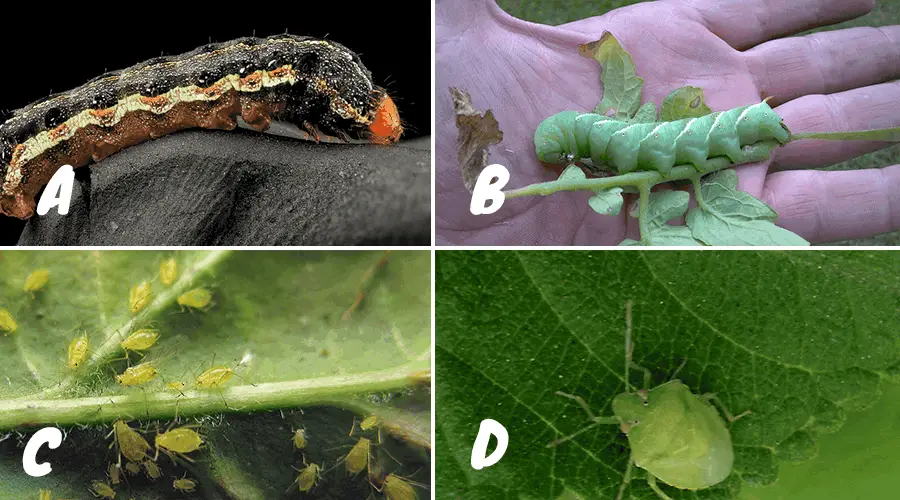
Bugs.
They are everywhere!
Some big, some microscopic.
Some bad and a lot more good.
Dealing with pests is part of life in the garden, especially in Florida.
Those gardeners to the northern part of the state deal with freezes that kill many plants but those same frigid temps also kill off insects.
For us in the central and southern parts
They love it here!
There are all sorts of bugs that wreak havoc on your garden.
Leafminers will bore into your plants leaves and eat it’s insides. They leave white squiggly lines on your leaves. They damage your plant by transmitting disease.
There are some that will take their little stupid needle-shaped mouths and pierce your plant to drink its juices and flesh. Aphids, thrips, and stinkbugs are the most common pests that damage your plants in this way.
Many caterpillars and beetles will just eat your plants leaves like salad.
Disease And Pest Resistance
I make it seem like there are a lot of bugs that can harm your plants, and there are but there are way more bugs that are beneficial to your garden.
Pests aren’t the only things that we have to worry about. Diseases can run rampant in your garden if not handled.
The best disease and pest resistance
And since there are more good bugs than bad bugs you raise the odds in your favor.
Lots of time bugs aren’t what kills your plant. The real problem it’s that you forgot to fertilize your plant, weed your garden or had your plants on a fluctuating watering schedule.
Pesticides
I bet part of the reason you want to grow your own veggies is because you want the, to be healthier and chemical free.
A great way to assist you plants in being pest free is to attract lots of “good’ bugs to the garden.
These are bugs that will assist you in pollinating your garden and actually eliminate some of the other bad bugs.
You can attract these good bugs by planting Nectar plants like basil, blanket flower, marigolds and lavender.
You Might Also Like: The Best Plants To Attract Beneficial Insects To Your Garden.
If action needs to be taken you can usually get the situation under
- B.t
.( Thuricide) – a spray that kills all caterpillars - Neem oil – controls a wide range of harmful bugs like aphids and
stinkbugs - Copper Fungicide – Controls a range of diseases like blight and mildew.
If you’ve had problems in the past it’s a good idea to get on a spraying schedule for these guys too. It’s better to prevent a bug attack then to have to eradicate seemingly, thousands of bugs.
The important thing to remember about chemical controls is that they don’t pick favorites. So when you spray these things in the garden you also run the risk of killing the ‘good” bugs too.
So it’s good practice to spray when pollinators and other beneficial insects are least active.
This is usually in the late afternoon headed into the evening.
Spray late enough that the bugs aren’t as active but early enough to let the plants not be wet before the sun goes all the way down.
While I have sprayed my garden before I try to avoid it at all costs. I don’t like to rely on chemical action because I think that it is harmful for the ecosystem of the garden.
Getting Started In The Florida Garden
Gardening in Florida is fun, frustrating, sweaty, and rewarding. Lots of common advice that you find on the internet doesn’t always apply to Florida.
This is especially true when it comes to timing. We put our vegetables in the ground at different times of the year compared to other states. We also have a very long state and the North and Southern parts have completely different planting schedules.
Follow the planting chart above to know when to plant what.
Find out what varieties you want to plant and order your seeds
Assess your space. Know how much space with good light(at least six hours of direct sunlight) you’re working with.
Get a journal and doodle out your garden.
Keep note of when events happen like heavy rains and fertilizer applications.
Florida soil kinda sucks. Build the best soil that you can for your vegetables. Mix in organic matter like peat moss and compost. Don’t forget about the mulch.
Plan to fertilize your plants once every three weeks with organic fish emulsions.
Be prepared for the bugs. Growing a healthy plant is more than half the battle. Planting nectar plants along side your veggies to attract good bugs also helps. However there are some times when chemical action is needed.
Lastly, which is the most rewarding part, Harvest your garden.
Don’t be afraid to pick those beans and matos. The more you pick the more signs that sends to the plant to make more.
This is what you’ve been working towards and It’s a great feeling to be able to share food from your garden with your friends and family.

Get your Free Florida Vegetable Gardening Guide.
You Might Also Be Interested In: The Best Florida Food Forest Plants
